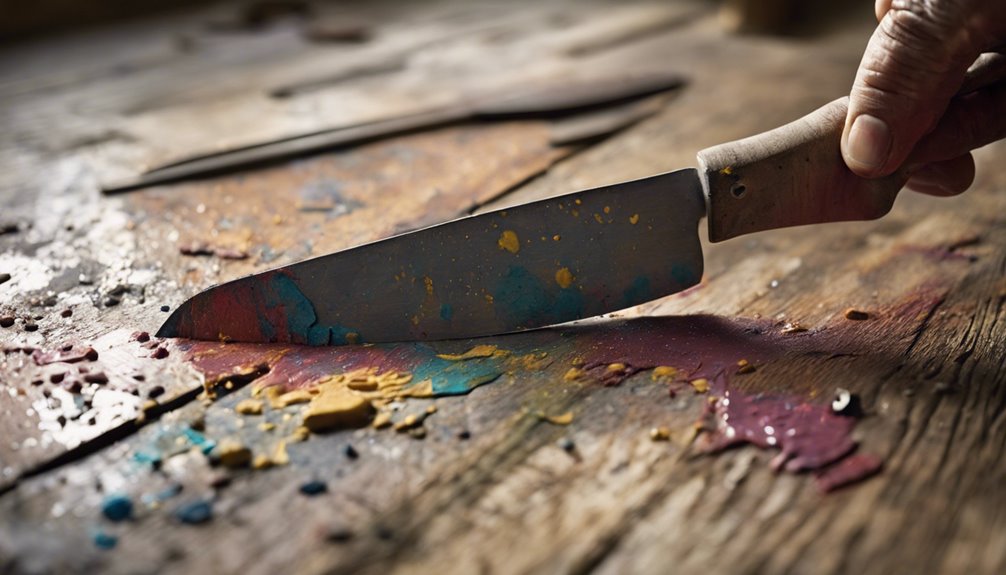To get paint off your wood floors, start by evaluating the type of paint. Gather supplies like a paint scraper, mineral spirits, and rags. Test a small area with your chosen solvent to check for any damage. Once it's safe, apply the solvent, wait for it to soften the paint, and gently wipe it away. If needed, use a soft-bristle brush for detailed spots. After removing the paint, clean the area with soapy water or a vinegar solution, and dry thoroughly. This careful approach can help restore your floors, revealing more tips and techniques as you proceed further.
Assess the Paint Type

How can you tell what kind of paint is on your wood floors? Start by examining the paint's texture and finish. If it's glossy, it's likely an oil-based paint, known for its durability and surface compatibility with wood. A matte or satin finish usually indicates latex paint, which is water-based and easier to remove but may not adhere as well in certain areas. You can also test a small, inconspicuous area with a solvent; if it softens, you're dealing with oil-based paint. Knowing your paint types is essential for selecting the right removal method and ensuring you don't damage the wood. Understanding this will empower you to reclaim your floors without unnecessary hassle.
Gather Necessary Supplies
Before you start tackling the paint on your wood floors, it's crucial to gather all the necessary supplies. Create a supply checklist to guarantee you have everything you need. Key items include a paint scraper for removing stubborn paint, rags or paper towels for cleanup, and mineral spirits or a paint remover suitable for wood. Don't forget a bucket for mixing solutions and a pair of gloves to protect your hands. You might also want a soft-bristle brush for detailed work. Finally, having a vacuum or broom on hand can help keep your workspace tidy. With these vital tools ready, you'll be well-prepared to make your wood floors look great again.
Test a Small Area

Wondering if the paint remover you chose will damage your wood floors? It's essential to test a small area first to guarantee it won't affect the paint durability of your finish. Choose a discreet spot, apply the remover, and wait for a few minutes to see how it reacts. Here's a handy table to guide you:
| Test Area Location | Result | Action Needed |
|---|---|---|
| Corner of a Room | No Damage | Continue Use |
| Under a Rug | Minor Damage | Find Alternative |
| Behind a Furniture | Significant Damage | Stop & Reassess |
| In the Hallway | Neutral | Safe to Proceed |
Use Solvents for Removal
Using solvents can be an effective way to remove paint from wood floors, and there are several options available. Common solvent types include mineral spirits, acetone, and denatured alcohol. Before applying any solvent, make certain to test it in a small, inconspicuous area to check for damage or discoloration. When working with these solvents, safety precautions are essential; always guarantee proper ventilation by opening windows and using fans. Wear gloves and goggles to protect your skin and eyes from irritation. Apply the solvent directly onto the paint, allowing it to sit for a few minutes to soften the paint. Then, gently wipe it away, working in small sections for the best results. Enjoy the freedom of restoring your wood floors!
Try Scraping Techniques

Scraping techniques can effectively lift paint from wood floors without damaging the surface underneath. You'll want to gather the right scraping tools, such as a putty knife or a paint scraper, and understand how to position them at different scraping angles for best results.
Here's a quick guide to help you:
| Scraping Tool | Ideal Scraping Angle |
|---|---|
| Putty Knife | 30 degrees |
| Paint Scraper | 45 degrees |
| Utility Knife | 15 degrees |
| Plastic Scraper | 60 degrees |
| Multi-tool | Varies based on tip |
Employ Heat Methods
If you're looking to remove paint from your wood floors, using heat can be an effective method. A heat gun can soften the paint, making it easier to scrape off, while a hair dryer can work for smaller areas or more delicate surfaces. Just be sure to keep the heat source moving to avoid damaging the wood.
Use a Heat Gun
A heat gun can be one of your best tools for removing paint from wood floors, especially when dealing with stubborn spots. With the right heat settings, you can soften the paint, making it easier to scrape away.
Before you start, remember these safety precautions:
- Protective gear: Wear gloves and goggles to shield yourself from heat and debris.
- Ventilation: Verify the area is well-ventilated to avoid inhaling fumes.
- Keep a safe distance: Hold the gun about 4 to 6 inches away to prevent damaging the wood.
With patience and care, you'll reclaim your beautiful floors and breathe easy, knowing you've tackled the job on your own terms.
Try a Hair Dryer
Using a hair dryer can be an effective and accessible way to remove paint from wood floors without the risk of damaging the surface. Start by setting your hair dryer to a medium heat setting; high heat can scorch the wood. Hold the dryer about 6 inches away from the paint and move it in circular motions to evenly distribute the heat. As the paint warms up, it'll start to soften, making it easier to scrape off using a plastic scraper. Be patient and work in small sections to guarantee thorough removal. This method is ideal for minor spills or drips, and it's a great alternative to harsher paint removal techniques, allowing you to maintain your floor's natural beauty.
Consider Natural Solutions

While chemical solutions can be effective for removing paint from wood floors, many homeowners prefer to contemplate natural alternatives that are safer for both the environment and indoor air quality. You might consider a vinegar solution, which can break down paint without harsh chemicals. A citrus solvent is another fantastic option, offering a pleasant scent while effectively tackling stubborn spots. Baking soda mixed with water can create a paste, perfect for gentle scrubbing. Adding essential oils not only enhances the fragrance but can also provide additional cleaning properties.
- Experience the peace of mind that comes with natural cleaning.
- Feel empowered by choosing eco-friendly solutions.
- Enjoy a fresher, healthier living space for your family.
Clean Up Residue
After successfully removing paint from your wood floors, it's crucial to clean up any residue left behind. Start by using a soft cloth or sponge dampened with warm soapy water. Gently wipe the affected areas to lift any remaining particles. For tougher residue, consider using a mixture of equal parts vinegar and water, which can act as an effective cleaning technique. Avoid harsh chemicals that can damage your wood. Once you've completed the residue removal, follow up with a clean, dry cloth to absorb excess moisture. This step guarantees your wood floors stay in great condition and ready for use. Regular maintenance with appropriate cleaning techniques will help preserve the beauty and integrity of your flooring.
Restore the Wood Finish

Once you've removed the paint and cleaned the residue, restoring the wood finish is essential for maintaining the floor's appearance and longevity. You can use various wood restoration techniques to revive the beauty of your floors. Start by sanding the affected areas lightly to smooth out imperfections. After that, choose a high-quality wood finish that suits your style.
Here are some finish application tips to contemplate:
- Apply in thin, even coats for a seamless look.
- Allow adequate drying time between each coat.
- Buff the surface after the final coat for a glossy sheen.
Prevent Future Paint Stains
Restoring the wood finish not only enhances your floor's appearance but also sets the stage for preventing future paint stains. To keep your floors looking pristine, consider these prevention tips:
| Tip | Details |
|---|---|
| Use Drop Cloths | Cover areas where you're painting. |
| Apply Protective Coatings | Consider using polyurethane for better durability. |
| Tape Off Edges | Use painter's tape to create clean lines. |
| Regular Maintenance | Clean spills immediately to avoid stains. |
Frequently Asked Questions
Can I Use Vinegar to Remove Paint From Wood Floors?
Yes, you can use vinegar for paint removal, but its effectiveness varies. Vinegar's acidic properties might soften some types of paint, making it easier to scrape off. However, it's not always the best solution for stubborn paint. If you find vinegar ineffective, consider alternatives like rubbing alcohol, acetone, or commercial paint strippers. Always test any method on a hidden area first to avoid damaging your wood floors.
How Long Should I Let Solvents Sit Before Wiping Them Off?
When using solvents, it's essential to let them sit for about 10-15 minutes before wiping them off. Did you know that nearly 70% of DIYers underestimate the time needed for solvent application? Different solvent types, like acetone or mineral spirits, require specific application techniques for best results. Allowing the solvent to work on the surface helps break down the paint more effectively, giving you the freedom to restore your wood floors beautifully.
Will Removing Paint Damage My Wood Floor Finish?
When you're considering paint removal techniques, you might worry about damaging your wood floor finish. It's important to choose methods that protect that finish. Using gentle solvents or scraping tools can minimize harm, but always test in an inconspicuous area first. Avoid harsh chemicals that can strip the finish. With the right approach, you can effectively remove paint while keeping your floor looking great, preserving its beauty and integrity.
Is It Safe to Use a Heat Gun on Hardwood Floors?
Using a heat gun on hardwood floors can be risky. While it can effectively remove paint, you've got to prioritize heat gun safety. High temperatures might warp or scorch the wood, damaging the finish. To protect your hardwood floor care, keep the heat gun moving and at a safe distance. Always test a small area first. If you're unsure, consider alternative methods to avoid any long-term damage to your beautiful floors.
What Should I Do if the Paint Won't Budge?
Imagine a stubborn stain, like a bad memory that just won't fade. If the paint won't budge, try various paint removal techniques. Start with a safe solvent, applying it gently and letting it sit. If that doesn't work, consider using a plastic scraper or heat. For really stubborn paint solutions, you might need to repeat the process or switch to a more potent remover. Patience and persistence can set you free!




